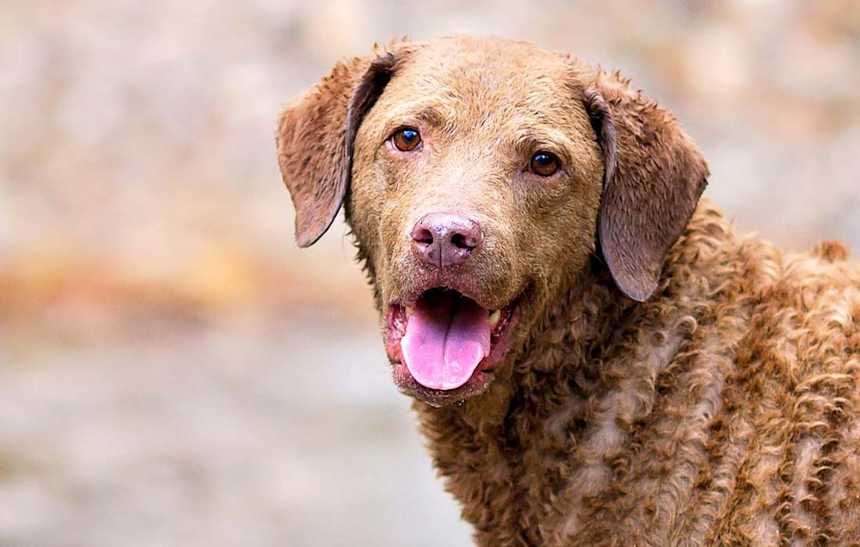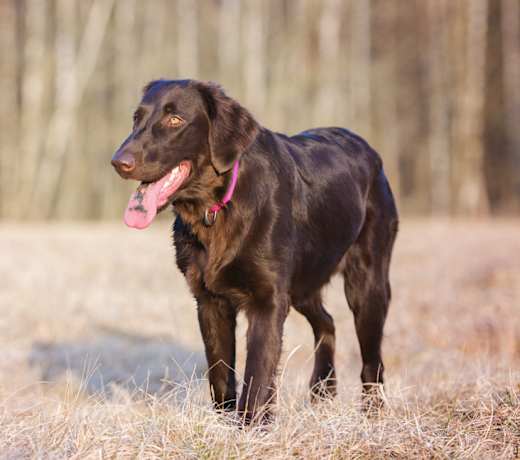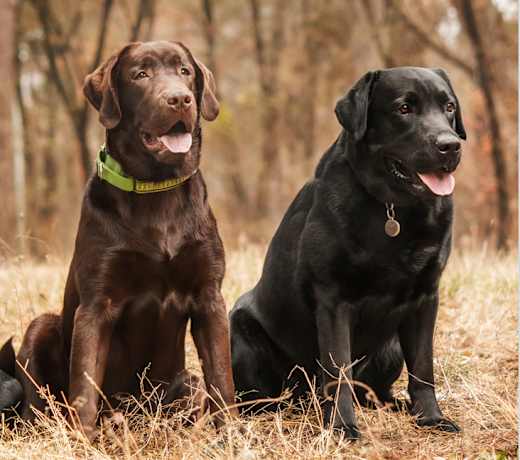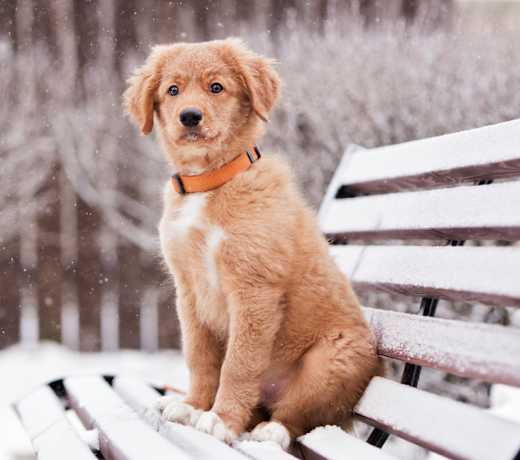Chesapeake Bay Retrievers are large dogs. They tend to weigh between 48 and 87 pounds and stand 21 to 26 inches tall at the shoulder, while females are slightly smaller.
Chesapeake Bay Retriever
Breed Type: Sporting
Common nicknames: CBR, Chessie, Chesapeake
Coat: Double
Hypoallergenic: No, they will likely trigger allergies.
Temperament: Affectionate, protective, loyal, smart
Life expectancy: 10-13 years
Color & patterns: Brown

The Chesapeake Bay Retriever, often known as the “Chessie,” combines athleticism, intelligence, and unwavering loyalty. With their strong and muscular build, they are natural-born swimmers and excel at retrieving in the water. This breed is also known for their determination and work ethic, making them excellent hunting companions and versatile working dogs, but they are also loving and devoted family pets who form strong bonds with their families. If you’re seeking a pup who can keep up with an active lifestyle, the Chesapeake Bay Retriever could be the breed for you.
Chesapeake Bay Retriever characteristics
Learn about about Chesapeake Bay Retriever basics like their fur colors, shedding levels, how much grooming they need, and other Chesapeake Bay Retriever facts.
Average height
21-26 inches (53.3-66.0cm)
Average weight
48-87 pounds (21.8-39.5 kg)
Average lifespan
10-13 years
Exercise needs
Grooming needs
Full-grown size
Good with cats
Good with kids
Training aptitude
When do Chesapeake Bay Retrievers stop growing?
Chesapeake Bay Retrievers stop growing between 12 to 18 months of age. They experience an initial growth spurt in their first six to 12 months, with the majority of their growth occurring during this period. They will continue to fill out and develop muscle tone until they are about 18 months old. Growth rates can vary, so some individual dogs might take a bit longer to reach their full size.
What colors do Chesapeake Bay Retrievers come in?
Chesapeake Bay Retrievers come in several colors, including brown (also known as “chocolate”), dark brown, light brown, and tan. Their coats are typically solid in color.
Do Chesapeake Bay Retrievers shed?
Yes, Chesapeake Bay Retrievers shed. Moderate to heavy shedding can be managed with regular brushing. A weekly brush with a proper, non-wire brush will ease shedding, help distribute oils throughout their coats, and keep them looking healthy.
Chesapeake Bay Retriever temperament
Learn about about the Chesapeake Bay Retriever temperament and how well they fit into your lifestyle, home environment, and family.
Are Chesapeake Bay Retrievers good with kids?
Yes, Chesapeake Bay Retrievers are good with kids. They are gentle playmates who are patient with and tolerant of young children.
As with any breed, it is recommended that your child is always supervised when interacting with your dog to keep both the child and dog safe. Teaching children how to properly approach and handle dogs is crucial to ensure positive experiences for both the dog and the child, as is teaching dogs how to interact gently with children.
Are Chesapeake Bay Retrievers good with cats?
Yes, Chesapeake Bay Retrievers are usually good with cats. This is a polite breed, but due to their hunting background, they also possess a strong prey drive that makes them more inclined to chase smaller animals, including cats. Of course, each dog (and cat) has their own preferences and temperament, and early socialization is key to a positive relationship between a Chesapeake Bay Retriever and a cat. If properly socialized and/or introduced at a young age, you can feel confident your Chesapeake Bay Retriever and feline family member should get along just fine.
Are Chesapeake Bay Retrievers good with other dogs?
Yes, Chesapeake Bay Retrievers are good with other dogs, especially if they have been socialized from a young age. They tend to have a friendly and balanced disposition, which helps them interact well with other dogs.
While they are not aggressive, the Chesapeake Bay Retriever’s strong prey drive and hunting background can lead to assertiveness or dominance with other dogs, particularly those of the same sex. Early socialization and positive interactions with a variety of dogs can help mitigate any potential issues and encourage good behavior. With the right training and socialization, they can thrive in multi-dog households and enjoy positive relationships with their canine companions.
Do Chesapeake Bay Retrievers bark a lot?
No, Chesapeake Bay Retrievers do not bark a lot. Like most retrievers, Chesapeake Bay Retrievers bark to alert but are not excessive barkers. As with any dog, they can be discouraged from barking as frequently with proper training and exercise.
Are Chesapeake Bay Retrievers good family dogs?
Yes, Chesapeake Bay Retrievers are good family dogs — some would say even excellent. Devoted, affectionate, and protective companions, the Chesapeake Bay Retriever is loyal and forms strong bonds with family members. They need plenty of exercise to be happy, so an active family is the best match for this breed’s playful and energetic disposition.
Are Chesapeake Bay Retrievers easy to train?
Yes, Chesapeake Bay Retrievers are relatively easy to train. They are intelligent and eager to please, valuable traits that contribute to trainability. Chesapeake Bay Retrievers respond well to positive reinforcement techniques, such as praise, treats, and play.
Of course, ease of training will depend on the individual dog’s personality and the training approach. Also, keep in mind that even if a certain dog breed is known to be easy to train, training any dog requires a long-term commitment.
Are Chesapeake Bay Retrievers smart?
Yes, Chesapeake Bay Retrievers are smart dogs. Their intelligence and keen problem-solving abilities are reflected in their superior performance as hunting and retrieving dogs. Chesapeake Bay Retrievers can understand and execute complex commands, particularly when trained with positive reinforcement. Their intelligence also means they can be quite perceptive and responsive to their pet parent’s cues. Overall, their smarts and eagerness to work make them versatile and capable companions.
Are Chesapeake Bay Retrievers friendly?
Yes, Chesapeake Bay Retrievers are friendly. Chesapeake Bay Retrievers can be quite sociable, especially if they have been properly socialized. Initially, they might be reserved with strangers until they become familiar with them. Once they warm to you, this unwaveringly loyal pup may never leave your side, making them affectionate family companions.
Chesapeake Bay Retriever health
Learn about about the Chesapeake Bay Retriever health outlook and what diseases they may be prone to at various stages of their life.
Are Chesapeake Bay Retrievers hypoallergenic?
No, Chesapeake Bay Retrievers are not hypoallergenic. No dog breed is completely hypoallergenic, though some breeds are less likely to trigger allergies than others. The Chesapeake Bay Retriever's dense, water-resistant coat sheds and produces dander, which can contribute to allergic reactions in sensitive individuals. Regular grooming can help manage shedding and dander, but if you have allergies, it’s a good idea to spend time with the breed before bringing one home for good.
Do Chesapeake Bay Retrievers have health issues?
The Chesapeake Bay Retriever is generally healthy but may be susceptible to the following problems:
Hip and/or elbow dysplasia: Hip and elbow dysplasia are two of the most common skeletal diseases seen in dogs. They are similar diseases in which either the hip or elbow joint has grown abnormally or is misshapen. The abnormal shape prevents the joints and sockets from adequately meeting one another, resulting in rubbing and grinding instead of sliding smoothly. Though the main complication with hip dysplasia is joint instability, the abnormalities present in elbow dysplasia often result in pieces of bone and/or cartilage breaking loose and irritating the joint tissues. Over time, the rubbing from dysplasia can cause a variety of issues, such as pain, lameness, and secondary osteoarthritis. Surgery can fix the joint if diagnosed before the onset of arthritis. If you are rescuing a Chesapeake Bay Retriever, have them checked out by a vet to see if they are prone to getting dysplasia.
Eye issues: This breed may develop cataracts, a common eye condition that causes cloudiness in the eye and obstructs vision, and progressive retinal atrophy (PRA), a progressive degenerative disease affecting the retina that eventually leads to blindness.
Von Willebrand disease: Von Willebrand disease (vWD) is the most common inherited bleeding disorder seen in dogs. It happens when a dog does not produce enough of a specific protein that helps the blood cells used in clotting stick together. This results in dogs that are unable to clot properly and could cause hemorrhages or other bleeding issues. The deficient protein is called von Willebrand factor (vWF).
Cranial cruciate disease: The cranial cruciate ligament is an important stabilizer in the knee joint. Cranial cruciate ruptures cause joint instability and are the most common cause of hind leg lameness in dogs. Surgery is recommended to prevent the tear from progressing to more severe joint disease.
Others: Gastric dilatation-volvulus, a sudden, painful, and life-threatening swelling and twisting of the abdomen. Your vet may recommend hip, eye, and ear tests.
Chesapeake Bay Retriever history
Learn about where the Chesapeake Bay Retriever came from.
Where are Chesapeake Bay Retrievers from?
Chesapeake Bay Retrievers are from the Chesapeake Bay area in the United States. They were developed in the 19th century to help hunters retrieve waterfowl from the icy waters of the bay. The breed’s resilience and strong swimming abilities made them well-suited for this challenging environment. They are known for their distinctive oily coat that helps insulate them in cold water, as well as their loyal and hardworking nature.
There is a popular origin story that Chesapeake Bay Retrievers come from two Newfoundlands rescued from a sinking ship, with an infusion of various Irish Water Spaniels to account for the breed’s wavy coat, but there is no historical documentation to support this.
How long do Chesapeake Bay Retrievers live?
Chesapeake Bay Retrievers live 10 to 13 years on average. Like all breeds, their longevity can be influenced by factors such as genetics, overall health, diet, and the quality of veterinary care they receive. Regular check-ups and a healthy lifestyle can contribute to a longer, healthier life for these active and resilient dogs.
What two breeds make up a Chesapeake Bay Retriever?
The two breeds that make up the Chesapeake Bay Retriever are not definitively known. Among the dogs thought to be in the genetic mix are Newfoundlands, Irish Water Spaniels, and hounds of undetermined origin. By the time the American Kennel Club was founded in 1884, a definite Chessie type had been established.
What is the difference between a Chesapeake Bay Retriever and a Labrador Retriever?
Chesapeake Bay Retrievers and Labrador Retrievers, while both beloved for their retrieving abilities, differ in several key aspects. The Chesapeake Bay Retriever, developed in the Chesapeake Bay area of the U.S., is known for its dense, water-resistant coat with a distinctive oily texture and rugged appearance. Their coat, which comes in shades of red, brown, or tan, is designed to withstand cold water, reflecting their role as retrievers in harsh conditions. They are more reserved and independent than Labs, exhibiting a strong work ethic and loyalty, particularly in hunting and retrieving tasks.
In contrast, the Labrador Retriever, originating from Newfoundland and refined in the United Kingdom, has a shorter, softer coat that is dense, smooth, and not oily. Labradors come in black, yellow, or chocolate colors and are characterized by their friendly, outgoing nature and athletic build. They are known for their eagerness to please and high energy, making them excellent family pets and versatile working dogs. While both breeds require regular exercise and thrive on activity, the Chesapeake Bay Retriever is more sensitive than the Labrador Retriever.
Are Chesapeake Bay retrievers rare?
No, Chesapeake Bay Retrievers are not rare. Though they are less common than Labrador Retrievers, they are not extremely hard to find. They are a well-established breed with a dedicated following, especially among hunters and others who appreciate their unique traits. Their relative rarity compared to more popular breeds like the Labrador Retriever or Golden Retriever can sometimes make them less visible, but they are well-regarded within the dog community and maintain a stable, if smaller, presence.
Popular Chesapeake Bay Retriever mixes
A few breeds that commonly mix with the Chesapeake Bay Retriever include:
Chesador (Chesapeake Bay Retriever + Labrador Retriever)
Chesapoo (Chesapeake Bay Retriever + Poodle)
Pointer Bay (Chesapeake Bay Retriever + German Shorthaired Pointer)

Find Chesapeake Bay Retriever puppies near you
Adopting a Chesapeake Bay Retriever
We don't see any Chesapeake Bay Retrievers available for adoption in your exact location or cities near you, but here are some adorable similar breeds in Beverly Hills, CA.

RICO
Labrador Retriever
Male, 4 yrs 6 mos
Beverly Hills, CA
Good with dogs
House-trained
Spayed or Neutered
Shots are up-to-date

Duncan
Labrador Retriever
Male, 9 yrs 1 mo
Los Angeles, CA
Good with dogs
Good with cats
Needs special attention
House-trained
Spayed or Neutered
Shots are up-to-date

Stella
Labrador Retriever
Female, 8 yrs 6 mos
Los Angeles, CA
Not good with dogs
Not good with cats
Needs experienced adopter
House-trained
Spayed or Neutered
Shots are up-to-date

Donna
Labrador Retriever Cattle Dog
Female, 2 yrs 3 mos
West Hollywood, CA
Good with dogs
House-trained
Shots are up-to-date

Snuffles
Labrador Retriever German Shepherd Dog
Male, 7 yrs 9 mos
Los Angeles, CA
Needs experienced adopter
House-trained
Spayed or Neutered
Shots are up-to-date

Logan
Labrador Retriever
Male, 1 yr 10 mos
Los Angeles, CA
Spayed or Neutered
Shots are up-to-date

Loreto
Labrador Retriever American Pit Bull Terrier
Male, 4 yrs 7 mos
Los Angeles, CA
Not good with cats
Needs experienced adopter
House-trained
Spayed or Neutered
Shots are up-to-date

Adelina
Labrador Retriever German Shepherd Dog
Female, 2 yrs 5 mos
Los Angeles, CA
Spayed or Neutered
Shots are up-to-date

RICO
Labrador Retriever
Male, 4 yrs 6 mos
Beverly Hills, CA
Good with dogs
House-trained
Spayed or Neutered
Shots are up-to-date

Duncan
Labrador Retriever
Male, 9 yrs 1 mo
Los Angeles, CA
Good with dogs
Good with cats
Needs special attention
House-trained
Spayed or Neutered
Shots are up-to-date

Stella
Labrador Retriever
Female, 8 yrs 6 mos
Los Angeles, CA
Not good with dogs
Not good with cats
Needs experienced adopter
House-trained
Spayed or Neutered
Shots are up-to-date

Donna
Labrador Retriever Cattle Dog
Female, 2 yrs 3 mos
West Hollywood, CA
Good with dogs
House-trained
Shots are up-to-date

Snuffles
Labrador Retriever German Shepherd Dog
Male, 7 yrs 9 mos
Los Angeles, CA
Needs experienced adopter
House-trained
Spayed or Neutered
Shots are up-to-date

Logan
Labrador Retriever
Male, 1 yr 10 mos
Los Angeles, CA
Spayed or Neutered
Shots are up-to-date



